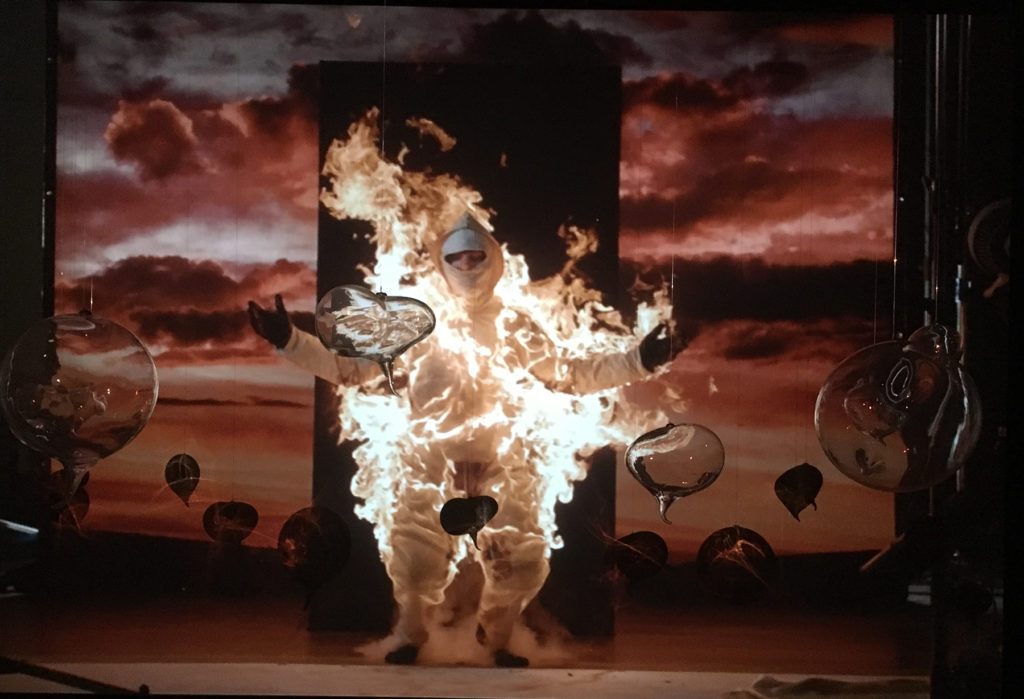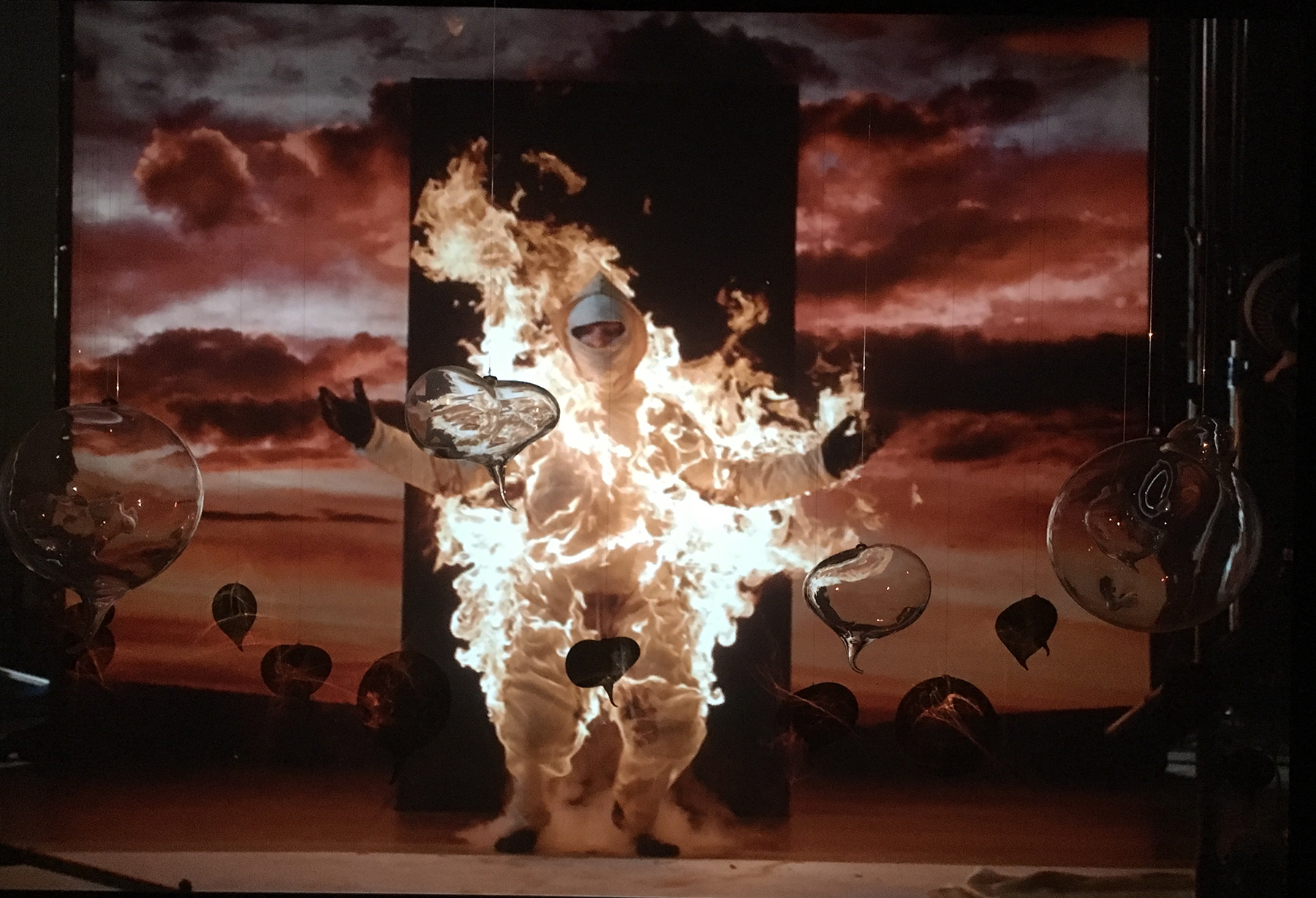by Sara Farrell Okamura
It opened with a funeral procession. A mariachi band, the artist, Vincent Valdez playing trumpet, led a band of mourners channeling a New Orleans jazz–styled funeral march through the newest exhibit to open at MASS MoCA. Pallbearers hoisted Requiem, a black patina bronzed colossal carcass of an American Bald Eagle, to their shoulders, carrying him past the monumental charcoal drawings of Robert Longo, past Robert Taplin’s giant alabastrine clown, Punch (Punch & Judy puppets) silently preaching to an imaginary crowd, past the immense green squares of MPA’s examination of binaries, past Hayv Kahraman’s Three Celebrities, depicting an image of three women arguing over a pile of gold, a treasure secured by appropriating the suffering of refugees, past Christopher Mir’s paintings, symbolizing anxieties and hopes, past Titus Kaphar’s paintings and sculptures correcting history. The American eagle, created by Valdez and fellow artist Adriana Corral, was lowered to lie in repose in front of Corral’s white wall with 243 dates embedded into the museum’s drywall, submitted by 243 Americans (one for each year designating the age of the United States). Each of these dates symbolized a personal or historical event. Suffering from Realness was now on view to museum visitors.
The exhibit, curated by MASS MoCA’s senior curator and managing director of exhibitions, Denise Markonish was inspired by an Adam Curtis film, “HyperNormalization.” This is a term, best described with a quote from the film, “We live in a world where the powerful deceive us. We know they lie, they know we know they lie, they don’t care. We say we care, but we do nothing. And nothing ever changes. It’s normal. Welcome to the post-truth world.” The documentary confronts how politicians and corporations have deliberately set out to manipulate us with and without our conscious acknowledgement, setting us up to accept the abnormal as normal. In the course of the last two years, during the misanthropic Trump administration, this practice has accelerated to a degree where abject cruelty towards children, state led violence toward people of color, attacks on gender equality, and imperialism are no longer perceived as shocking but are so prosaic as to have lost any stature as headline news.

In response to this, many artists are addressing the “realness” of their communities, using culture as a weapon, particularly in the United States. Markonish intends to shake us out of this comatose state with the work of 16 artists who never succumbed to automaton disassociation. Her intention is best described in her own words, “Ultimately, this exhibition aims to create a space of understanding and empathy. Because despite political tension, people are engaged—crying out for something better.” She titled the exhibit after a line from a Kane West/Jay-Z song where West raps, “Doctors say I’m the illest/’Cause I suffering from realness.” These lyrics were a precursor to the artist’s public struggles with mental health issues.
One of the most striking pieces that exemplify the essence of the show is Cassils’, Fourteen Encapsulated Breaths installed in front of their video “Inextinguishable Fire.” The title is taken from German filmmaker, Harun Farocki’s film about napalm attacks in Vietnam. The movie begins with Farocki speaking, “If we show you a picture of napalm burns you’ll close your eyes. First, you’ll close your eyes to the pictures, then you’ll close you eyes to the memory. Then you’ll close your eyes to the facts.” The video is a live performance where Cassils, encased in a fire resistant frozen suit is engulfed in flames for 14 seconds. The flames are then extinguished and they remove the suit. The audience is privy to the entire event and resulting effects. In the video, the footage is slowed down to fourteen minutes guaranteeing that the viewers see the full force of violence involving fire. Cassils, often uses their body as sculpture, describes in a New York Times interview (11/18/2015) with Stephen Heyman, the idea for the piece came when they were working as a personal trainer at a Crunch in Hollywood, “There I watched the battle of Fallujah on 22 different monitors simultaneously while blonde actresses were running at their optimal fat burn target heart rate. The disparity between those realities really informed this piece.” Cassils further explains, “When you look at me, you’re not seeing my body, you’re seeing, in this case, an abstracted human form engulfed in flames, and you can place yourself in that position for a moment and think about what it would be like to be subjected to that violence. Thinking about that may change the way you walk through the world.”

Recent McArthur Genius Award recipient Titus Kaphar, is not revising history through his work—he is rectifying it. On his website he states, “His practice seeks to dislodge history from its status as the “past” in order to unearth its contemporary relevance. He cuts, crumples, shrouds, shreds, stitches, tars, twists, binds, erases, breaks, tears and turns the paintings and sculptures he creates, reconfiguring them into works that reveal unspoken truths about the nature of history. In so doing Kaphar’s aim is to reveal something of what has been lost and to investigate the power of a rewritten history.” An example that speaks to fact over myth is A Pillow For Fragile Fictions. This is a blown glass bust of a disfigured George Washington resting on a pillow of marble. The stone mimics the traditional materials used to sculpt monuments that edit history. The bust contains rum, tamarind, lime and molasses, ingredients Washington received in exchange for a man who was his slave. This is just one of four of Kaphar’s works.
This is not a dystopian exhibit, but one that gives credence to the notion that it is a luxury to be immune to our current political state. Only those who can afford it can be passive. Each of these artists deserves their own review, my apologies to those not mentioned or only receiving a line. Having stated this, I am hoping a sampling of this show encourages all to see it, again and then again. MASS MoCA will be free to the public on May 25, its anniversary.


















May I please quote this article and use the art photos on Titus Kaphar? I’m a student at Springhill College in Mobile Al. writing a contempary art paper.